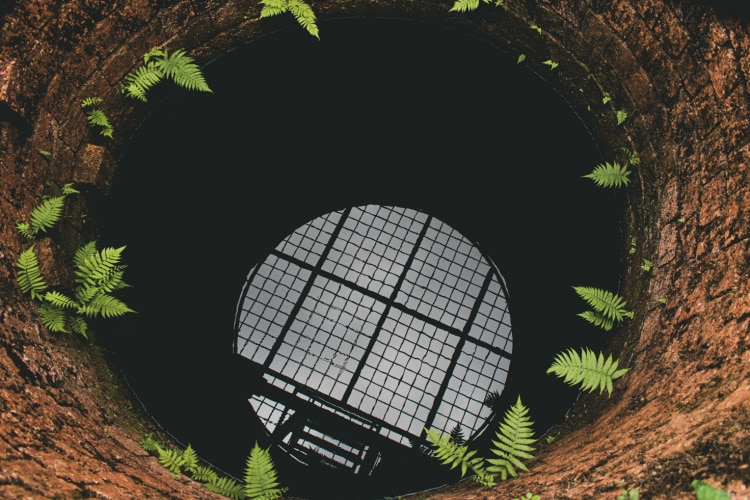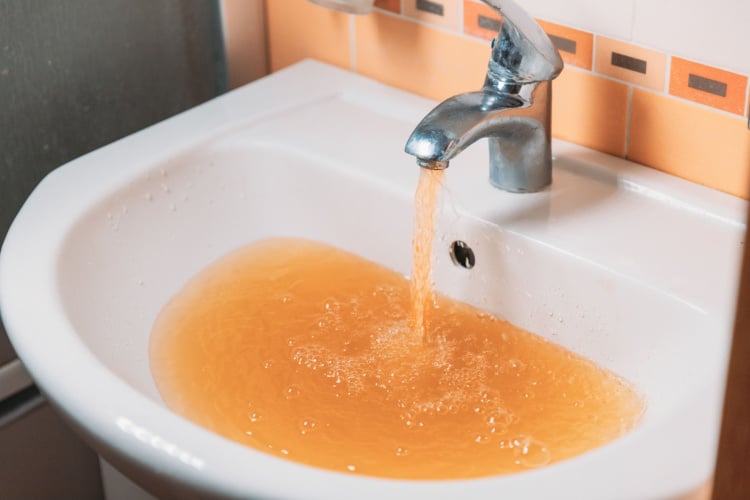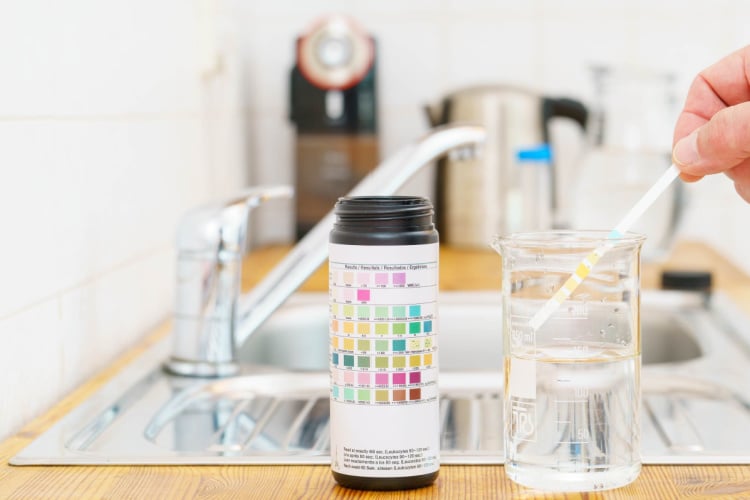Rust forms when iron and other minerals come into contact with oxygen and begin to oxidize. These oxidized minerals can cause severe damage to your pipes and your entire well system if you don’t take care of the issue immediately.
Luckily, while rust is commonly found in well reservoirs, there are several easy ways with which you can remove it. Let’s review them and see what’s the best course of action.
How Do You Get Rusty Well Water?

Wells draw their water from underground water sources called aquifers. These aquifers are essentially underground caverns filled with water.
The water in the aquifers comes from a nearby water source, such as a lake or river, or rainwater. Regardless of the origin of the water, the important thing to remember is that it seeps through the rocks and soil and collects underground.
The rocks and layers of soil through which the water travels contain minerals like calcium, magnesium, and, most commonly, iron. So, while it passes through them, many minerals dissolve in the body of water, making it mineral-rich.
Once enough water has accumulated in a certain place, an aquifer is formed, and people can put a well system to use for their drinking water needs.
However, since this water is rich in iron and exposed to oxygen, with time, the iron can oxidize (from dissolved to ferric iron) and lead to rusty water.
One important thing to note here is that iron-rich water does not necessarily mean that the water is prone to rust. It really depends on the type of iron present in the well water, which can be in three forms:
- Dissolved iron (also called clear water iron) is not visible in the water and does not cause staining
- Ferric iron is visible in the water and can cause staining. It is formed when dissolved iron comes in contact with oxygen.
- Ferrous iron also can’t be seen, but it can cause taste and odor issues, i.e., give water a metallic taste. It’s formed when acidic water corrodes iron or steel pipes.
Your well water will develop rust when ferric or ferrous iron is present.
Common Issues With Well Water Rust
One common problem with mineral-rich water is that mineral deposits may stick to the inside wall of the pipes and oxidize due to the presence of oxygen and moisture. This means that rust will form and begin to corrode the walls of your pipes, as well as fall into the water as it passes through the pipes.
Initially, this thin film of minerals can be cleaned out and scrubbed off, but that requires you to take apart your well system and clean out the pipes regularly, which isn’t feasible. In fact, in the beginning, you might not even know that this process is underway. Yet, that won’t stop the rust from slowly but surely eating the pipes and causing them to be more brittle.
It’s very common for brittle pipes to leak and eventually break completely.
Additionally, rust in water from corroded pipes is a health concern because pipes might contain copper and lead. On the other hand, rust from oxidized iron is not a health concern, but it will change the taste and odor of water.
More importantly, rusty water might act as a host to a large number of bacteria.
The Real Issue With Rust in Well Water
Damaged pipes and foul-tasting water are two major issues, but the real problem with rust in well water is iron bacteria.
There are a lot of different microorganisms that use minerals as a food source. Iron bacteria are the most common of these microorganisms, usually found in well reservoirs thanks to the hospitable conditions for their growth.
Iron bacteria are found on the same rocks and soil that contain iron and other minerals. They are flushed down into the aquifer along with the rainwater, and due to the presence of both iron and oxygen, they begin to grow. The presence of oxygen allows the bacteria to break down the iron and secrete a rust-colored slime.
The biggest issue with iron bacteria is that it’s incredibly difficult to remove. Iron-rich well water alone can easily be purified by installing water softeners and reverse osmosis filters, and even the damage to the pipes can be mitigated to a certain point. However, iron bacteria render filters useless because the slimy nature of the bacteria clogs up every system it touches. The bacteria also clog up pipes rapidly, causing rust to build up much more quickly and making your water practically undrinkable.
If you have a problem with iron bacteria, read our detailed guide on removing it effectively.[1]
Detecting Rusty Water from Well

One good thing about rusty well water is that it tastes, smells, and looks horrible. While this obviously doesn’t sound like a good thing, because of these drastic and easy-to-spot changes, you can easily detect it and take immediate action.
Rusty water has a very metallic aftertaste. Even if the water from your tap is clear, if you drink it, it’ll taste like pennies.
The more iron is present in the water, the more distinctly you’ll be able to pick it up. After a certain point, you won’t need to taste the water since the metallic smell will give it away.
Nevertheless, if you somehow don’t perceive the taste or the smell of the water, it’ll get to a point where the color itself will change. Depending on the iron concentration in the water, you’ll start to see a yellow, then orange tinge, and in extreme cases, the water might even turn reddish-brown.
Of course, this won’t happen overnight, and you need to ignore the state of your well for weeks or even months for the water to go from clear to brown.
Additionally, remember that there are two forms of iron that can cause rust – ferrous and ferric. With ferrous iron, the water comes out clear, but it starts to turn yellow or orange after a second or two in the glass. Ferric iron water, on the other hand, comes out of the tap looking rusty, so it’s easier to spot right off the bat.
As for iron bacteria, it’s the trickiest one to spot without proper testing. In the early stages, the bacteria might not discolor the water at all, and then you might start getting large clumps of rusty-looking slime in your glass.
Testing for Rust in Well Water

While you might be able to detect the iron and the rust in well water after it’s spread, there are methods that you can use to help you pick up any danger signs much earlier.
There are plenty of home water testing kits that allow you to see what the mineral concentration of your water is and if you have more iron than you should.
Of course, the most reliable method is, without a doubt, a water testing lab. All you have to do is get a plastic cup with a removable cap, fill it up to about ¾ with the water from your faucet, and then take that sample to the nearest water testing lab you may have near you.
The service is pricier than getting a home water testing kit. However, it’s significantly more reliable, as they test for many more common water contaminants. The test will explicitly tell you if the contaminant levels are too high without you needing to look up acceptable iron ppm (parts per million) levels to see if you have rusty water from the well.
Remember that you’ll need to fill out a special form if you also want to test for iron bacteria. All you need to do is either ask the receptionist at the lab for an iron bacteria testing form or fill out the regular form and specify that you’re testing for iron bacteria.
Treating Rusty Well Water
Because well water is so rich in minerals, it’s no surprise that the water coming out of it is usually hard. This essentially means that the magnesium and calcium present in the water are too high, which can lead to many issues.
These issues include laundry looking worn out, limescale forming on surfaces touched by the water, soap not lathering, and many more. Water softeners can neutralize these effects, as they use an ion exchange process to substitute the hard minerals with sodium molecules, thus softening the water.
However, while a softener can neutralize magnesium and calcium ions, it will have a harder time with iron ions. They still get replaced, but when it’s time for the regeneration process, a lot of iron stays in the resin tank and doesn’t get flushed. This leads to rust forming inside the tank if you don’t employ proper maintenance measures.
This is why we think you should combine your water softener with a pre-filter, a sediment filter, or a reverse osmosis filter. The pre-filters are the cheapest option and can remove large debris particles from the system. The sediment filters can range in size and price but typically have a much finer mesh screen than pre-filters designed to catch many more contaminants.
Reverse osmosis filters are the most varied units, costing anywhere from a couple of hundred dollars to several thousand dollars depending on your needs. We recommend going for a 1-micron filter since it has smaller holes in the screen, so the filtration is much more thorough than with a 5-micron filter or something larger.
Conclusion
The presence of iron in your well water is nothing to worry about since they’re very commonly found in underground aquifers.
However, once you start detecting traces of metal in your water, then it’s time to take measures to prevent the pipes from rusting and your well water from becoming unusable.
If the only issue with the water is rust, then a water softener with an attached filter will take care of the issue.
On the other hand, if there are iron bacteria in your reservoir, then it’s either time to call in the professionals or shock chlorinate the entire system before things get even worse.
link to the article on iron bacteria once live
My well has a bad smell and is ruining my laundry ,what can I do to solve this problem
Hi Tommy, do you have any kind of water treatment system currently for your well? Regardless, the best first step is to do a test of the water to make sure we have the facts about what’s in your well water. Please take a look at a well water test here to get started.